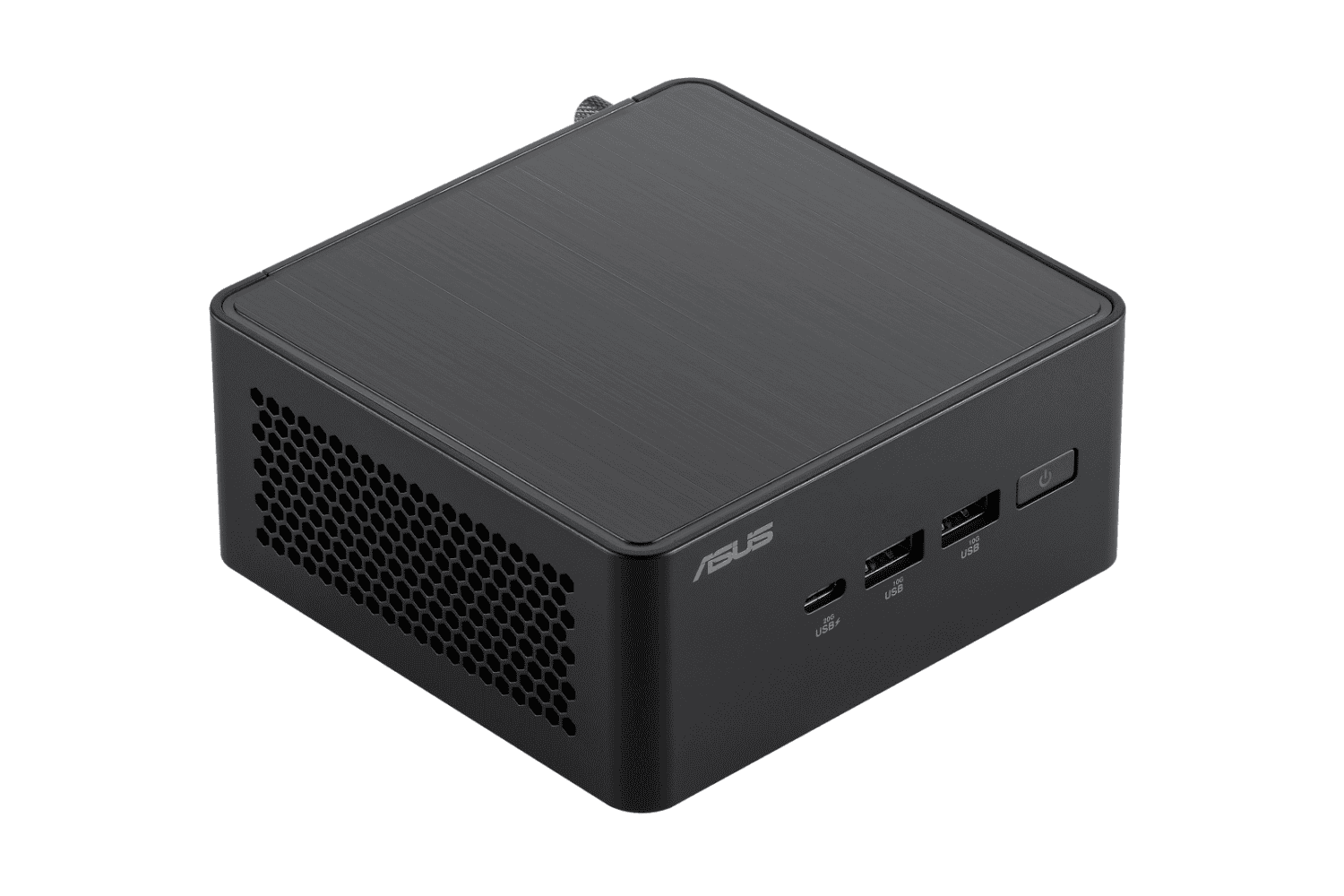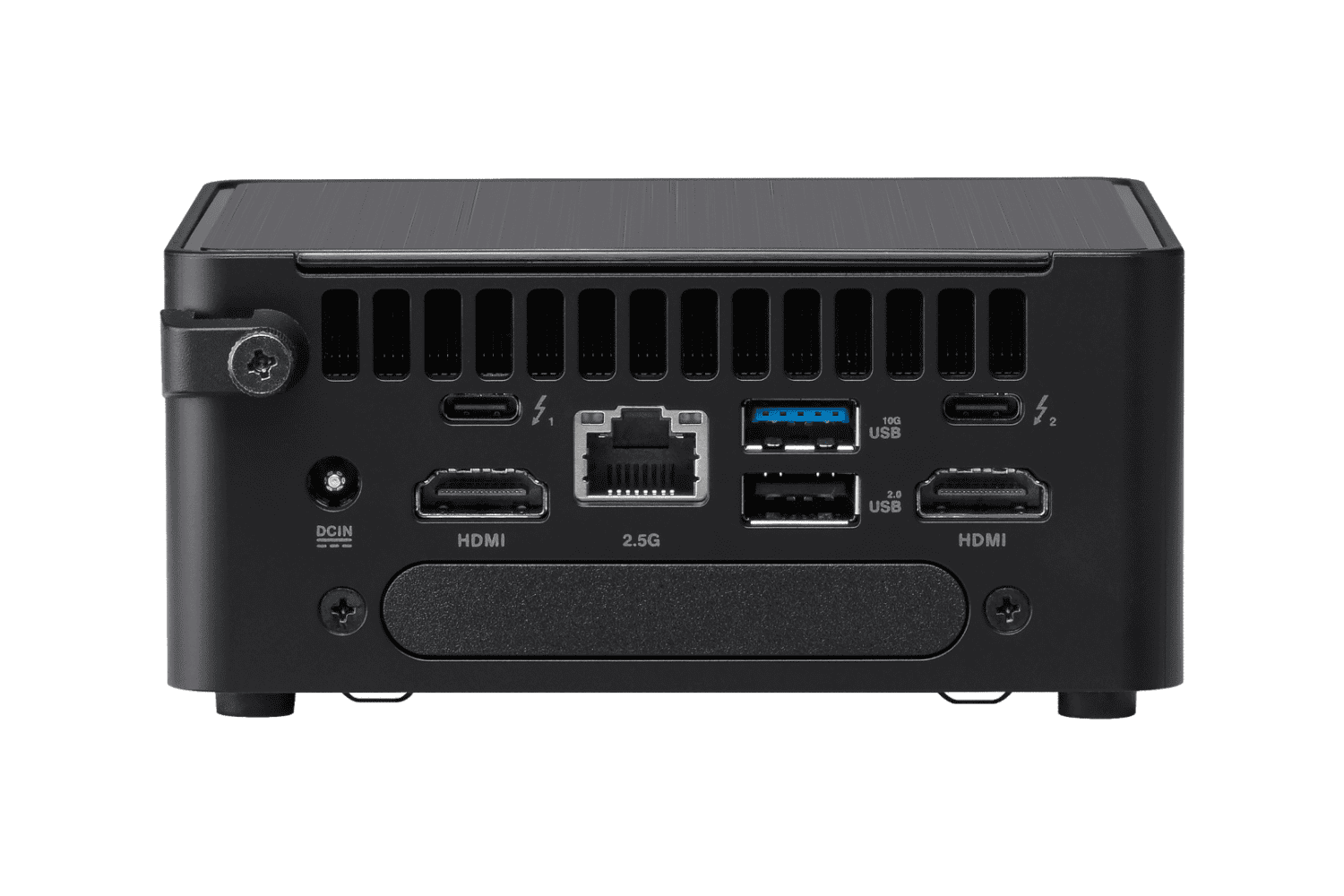In 2023, ASUS took over the torch from Intel, which had marketed no less than 13 generations of the Next Unit of Computing (NUC) since 2013. Part of the 13th generation was already built or marketed by ASUS. The 14th generation is the first that ASUS made fully in-house. What can you do with a NUC? Who might find it of use and interesting? And how do we rate the ASUS NUC 14 Pro in practice? Read all about it in this article.
ASUS is serious about its NUC line-up, that much is clear. It has already released a number of models since it took over responsibility for it from Intel. Last year, it came out with the 14th generation. ASUS’ website lists (besides some models from older series) the NUC 14 Essential, the NUC 14 Pro (in a tall and a slim variant), the NUC 14 Pro+ and the NUC 14 Pro AI+. We have also already seen a NUC 15 on the company’s website. This indicates that development remains well underway and that ASUS sees a future in this line of mini-PCs.
Different models for different purposes
We will not go into too much detail in this article about the differences between the various models of the latest ASUS NUC 14 line. These pretty much speak for themselves anyway. The NUC 14 Essential features an Intel Core i3 processor, the NUC 14 Pro and Pro+ feature an Intel Core Ultra (first generation, or Meteor Lake), and the NUC 14 Pro AI will be available with second-generation Intel Core Ultra processors (also known as Lunar Lake). The + in the names of the NUC 14 Pro+ and the NUC 14 Pro AI+ indicates that those can come with an Intel Core Ultra 9, where the “regular” NUC 14 Pro has at most an Intel Core Ultra 7.
All in all, then, we are talking about a lineup with different use cases. The ASUS NUC 14 Essential is suitable for relatively light tasks. Starting with the ASUS NUC 14 Pro, heavier tasks can also be performed on it. The NUC 14 Pro AI+ is the first true AI mini-PC in the ASUS NUC lineup, thanks to the Lunar Lake processor and the NPU that goes with it. 120 TOPS, divided between NPU, CPU and GPU, ensure this. Meteor Lake also already had an NPU, but it didn’t get much beyond a little over 10 TOPS. With that, it may not formally be called an AI PC.
In addition to “regular” NUCs, ASUS also has variants for specific environments in its lineup. For example, there is a variant that focuses specifically on gaming, but there are also ruggedized specimens for deployment in demanding environments. By the way, these no longer always have the normal NUC dimensions. If an RTX card from Nvidia has to be installed, it becomes difficult to maintain the square design, of course. Finally, it is possible to buy individual NUC components. These so-called NUC Elements can also come in the form of a PCIe expansion card, for example.
What is a Next Unit of Computing (NUC)?
The first question we want to answer is why Intel ever came up with the Next Unit of Computing. What is so “Next” about it? It’s not a desktop, but it’s not a laptop either. In terms of specifications, it kind of holds the middle ground between the two.
It looks like a desktop because of the lack of a battery and its static deployment. That is, a mini-PC such as an ASUS NUC will generally be in the same place constantly. In doing so, it will also need a continuous power supply. In addition, it uses a variety of external devices to function. Think keyboard, mouse, monitor, webcam and the like.

However, a mini-PC like the NUCs from Intel and nowadays ASUS is much more like a laptop inside than a desktop. The components, especially the CPU, always come from a processor manufacturer’s laptop line. In the case of the NUC, because of its history, that is obviously Intel. Then again, in terms of connections, a mini-PC is better equipped than a laptop. On the ASUS NUC 14 Pro we received from ASUS, there are two HDMI, two Thunderbolt, RJ45, one USB Type-C and four USB-A connectors. That’s not something you see on your average laptop.
Finally, the ASUS NUC 14 Pro offers another interesting bonus. You can buy it as a slim or a tall version. The tall one has room for an additional 2.5-inch SATA SSD or HDD if you want it. This extra storage comes on top of the two M.2 NVMe slots found on the NUC 14 Pro’s board. The tall variant is as wide and deep as the slim one (11.7×11.2 cm), but 5.4 cm high instead of 3.7 cm.
Article continues below the box
ASUS NUC 14 Pro: What’s it like as a work PC?
In the body text, we mainly talk about the general features of mini-PCs and, more specifically, ASUS’ NUC portfolio. Still, to get some hands-on experience, we also worked with the ASUS NUC 14 Pro for a while. We report on our experiences here.
In the spirit of full transparency, it is worth noting that we have been equipping our home office with a mini-PC for about five years. So there is no need to convince us of its benefits. One of the main ones we think is that it’s just really nice when you can sit down at your desk and there’s a PC waiting for you. You don’t have to get your laptop from somewhere and plug it in first. Granted, with a single Type-C connector, that’s not a lot of work these days. Still, things work just a little smoother with a mini-PC, as is the case with the ASUS NUC 14 Pro.
ASUS sent us the NUC 14 Pro with an Intel Core Ultra 7 165H on board. It’s the tall version, so with room for an additional 2.5-inch drive, on top of the two M.2 slots on the motherboard. In total, according to ASUS’ specifications, with all three slots filled, you can put a maximum of 10 TB of storage in this NUC 14 Pro. Good to know is that ASUS has made it possible to access the M.2 slots without the use of tools. That’s handy if you want to upgrade.
For those who like to know the details too, there is a version with ASUS logo and one without. We got the version without the logo, but with a very large HDMI logo up front. ASUS includes everything else you might need in the box of the NUC. That means the screws for the extra 2.5-inch drive and a VESA bracket for mounting on the back of a monitor or elsewhere are all included.
Given the large logo on the front, it’s not surprising that we see HDMI connectors on the ASUS NUC 14 Pro. Two to be exact. Along with two Thunderbolt connectors, this provides ample connection options for monitors. ASUS also included one RJ45 (2.5Gb), one USB Type-C (USB 3.2 Gen2x2) and four times USB-A (3x USB 3.2 Gen2 and 1x USB 2.0). All in all, we have more than enough there, also because our monitor has a USB dock built in. It is also worth mentioning that there is a Wifi 6E adapter on the board in the ASUS NUC 14 Pro. This can thus make use of the additional 6GHz band, provided that a router or access point offers it, of course.

ASUS delivers the NUC 14 Pro with Windows 11 Pro as standard. That makes sense given the target market and offers the necessary management options, including vPro and all that goes with it.
In practice, we had an excellent time working on and with the ASUS NUC 14 Pro. There are plenty of connections on it, as mentioned above. The Intel Core Ultra 7 165H provides more than enough processing power for all the individual tasks we wanted to perform with it. The Intel Arc GPU that is part of this processor also performs well for things like photo editing. That goes just a bit smoother on the ASUS NUC 14 Pro than on the laptops we also use regularly.
However, we did notice that the CPU does seem to run into its limits a bit at times. If we have a lot of tabs open, we notice that working in the CMS of our website doesn’t go smoothly. The little fan then blows very loudly as well. The latter is an issue anyway. There is a very enthusiastic fan inside the ASUS NUC 14 Pro. If you can’t stand that, we would definitely adjust the fan profile. If you usually work with headphones on, then it’s not necessary of course.
Mind you, both of the above “problems” are also just part and parcel of mobile processors. At least with laptops, we run into the exact same problems, often a bit faster and worse as well. So that can’t be called an ASUS-specific problem. Maybe we just need to look at a slightly more powerful system.
Turnkey or as a kit
One of the most distinguishing features of an NUC (and mini-PCs in general) is that most models can be purchased off-the-shelf or as a kit. Basically, a NUC always consists of an enclosure, motherboard, CPU and power supply. That’s it. That’s what ASUS calls the kit variant. You might know it by the term bare-bone. That can be useful if you have specific requirements for the remaining components. Or if you still have some things lying around that will fit in, because you already have a number of NUCs and would like everything to run on the same hardware for example.
The kit version of a NUC gives you a bit more freedom and flexibility than you get from a laptop and also from off-the-shelf desktops. Of course, it is more work to get it up and running. After all, you still have to do some work on it yourself. That’s why ASUS also offers variants that you can put on a desk and switch on right out of the box. In such a case, in the case of the ASUS NUC 14 Pro, you actually only choose which processor you want. And, of course, whether you want the high or the low version.
Lots of choice
All in all, there are quite a lot of SKUs for a product like the ASUS NUC 14 Pro. Different sizes, different scope of delivery and then also a lot of options in terms of processor. With five different processors, in high and low versions and ready or not, that quickly adds up in any case. That also means there is a lot of variation in price. For the cheapest kit, you’re done for less than 400 euros, the most expensive tall off-the-shelf variants go for prices over 1200 euros.
Such a spread in terms of price means you do have to sit down and figure out what you need. This is possible precisely because there are so many options. It may not make the decision any easier. On the other hand, you also have to make fewer concessions and can get things almost exactly the way you want them. Especially with laptops, that almost never works out.
A lot of choice, at least on paper, is interesting. But how many people and organizations really need or want this? At first you might think there aren’t that many. Yet there are quite a few possible uses for a mini-PC like the ASUS NUC 14 Pro we have on our desk. We’ll go into that in more detail in the remainder of this article.
The NUC as a work PC
The fact that there are many different models of a NUC must mean that there are multiple use-cases. There are several to consider for the business market.
First, there is the NUC as a replacement for the laptop and in some cases perhaps desktop on the desk. We wrote an extensive story several years ago. Although that was based on our experiences with a mini-PC from a different brand, the points from that story obviously stand.
We think a mini-PC undoubtedly has added value compared to a laptop in the workplace. More connections means that it is easier to connect extra screens and you don’t have to juggle with USB ports or an extra dock when you need to connect a new wireless receiver. Your laptop is also now no longer constantly on the charger. That most likely benefits its battery’s lifespan as well. With that, organizations should be able to use their devices longer.
A NUC is also convenient for system administrators, because now they know it is always there. Employees at home now won’t just connect a laptop other than the company laptop to the dock and monitor to quickly get some work done.
However, employees and organizations do need to adjust the way they work accordingly. One of the advantages of a laptop is that you have the same PC with you everywhere. With the same files and programs on it. For example, if you work at home on a mini-PC but also have a laptop for the office and on the road, this is not necessarily the case. The cloud is then the appropriate place to work in. That means using SaaS applications and central storage of files in the cloud, among other things. Also, there’s a price component to consider. That is, mini-PCs usually are additional to the other work PC investments. That may decrease the appetite at organizations to invest.
NUC at the edge
In addition to the staff workstation, the edge is also an interesting location for some ASUS NUC models. Think of IoT applications in locations where you really want or need a small PC. With the Rugged models, this is also possible in environments where a normal PC cannot run.
In such environments, it may be necessary to store the data locally first. This data is then processed on the device, after which it is sent to a central location. For many of these operations, extremely high performance is not necessarily important, so there is no need for a hugely bulky server. An ASUS NUC 14 Pro or NUC 14 Pro+ could be enough. The tall variant of the NUC 14 Pro then even offers the possibility of adding additional TBs with the 2.5-inch expansion slot.
Looking further to the edge, we see even more opportunities for deployment of an NUC. Think of digital advertising kiosks you see scattered around the country and in malls. These can be perfectly controlled by a NUC. The same goes for the kiosks you increasingly see in the hospitality industry (among other places), where you can check in or find directions. Furthermore, the relatively high number of video connections provides the necessary opportunities for video walls, or walls consisting of multiple screens.
Finally, it is also important here to mention the already NUC Elements we touched on briefly earlier. It is possible to buy the board as a NUC Element, but you can also buy a NUC Compute Element separately. This allows you to create a NUC in any environment, so to speak. If you already have a system running in a factory hall and would like to add a NUC to this system, for example to monitor the performance of all OT systems in that hall, you can add that using NUC Elements.
A NUC with AI: what can we expect from it?
We cited earlier that an ASUS NUC 14 Pro AI+ is coming soon. At 120 TOPS, this Lunar Lake-based latest version of the 14th generation of the Next Unit of Computing has considerably more AI capabilities than its Meteor Lake-based predecessor. ASUS is therefore marketing it as a Copilot+ PC. It features microphones for voice control (and speakers for response), a fingerprint reader and a genuine Copilot button.
So with the ASUS NUC 14 Pro AI+ Copilot+ pc, the company wants to get in on the AI PC game as well. In itself, this makes sense, as the mini-PC must compete with laptops in the workplace, as far as we are concerned. These will increasingly be Copilot+ PCs. ASUS should be able to offer a NUC that can compete with them. What is unfortunate (but understandable given the history of the NUC) is that, at least for now, all NUCs have an Intel CPU. More choice would be nice.
However, the ASUS NUC 14 Pro AI+ is not only interesting as a competitor to a laptop on a workstation. There is also room for AI on machines in edge environments. Think of the manufacturing industry where centralized and automated quality control takes place on samples before a “go” is given on production. This can theoretically be done on an AI PC. Admittedly, it will depend on the computing power required whether the current ASUS NUC 14 Pro AI+ can be used for this. NPUs may not be suitable for this (yet) and perhaps a workstation is a better option anyway. But we definitely see potential in deploying these kinds of mini-PCs with AI at the edge.

Conclusion: The NUC is very much alive
With Intel’s divestiture of the Next Unit of Computing, there may have been some concerns surrounding its future. Those appear to be unfounded based on what we have seen and heard. Intel carried out the transition period well, with ASUS becoming increasingly involved even before the final farewell from Intel. However, ASUS has also since launched a fairly extensive lineup entirely under its own banner. As soon as it was possible, it also immediately made one that goes through life as a Copilot+ PC. And we have also seen the first signs of the 15th generation here and there on the web.
To us, it is not a big surprise that ASUS seems to go all out for it. We may be a bit biased because we have been working on a mini-PC for many years, but the mini-PC and therefore the NUC certainly have a right to exist. As far as we are concerned, they are nicer to have on the desk than a laptop, because they are usually more powerful and have more connections. For organizations, there are also advantages in terms of reliable management of them. Of course, they should also consider the other side of choosing a mini-PC. It requires an additional investment if a laptop for travel is also required. It also places some demands on the way of working. The cloud must then be the starting point.
However, the greatest business opportunities for the NUC do not lie in the mini-PC as a laptop replacement, as far as we are concerned. Those lie at the edge, where small machines must do their work invisibly in sometimes suboptimal conditions. The NUC Elements are also aimed primarily at that kind of environment. With the arrival of a NUC geared more toward performing AI tasks, the capabilities there are expanded a bit further.
We haven’t heard the last of ASUS when it comes to the NUC portfolio (yet), that much is clear. So we would definitely recommend taking a look at mini-PCs and in this case the ASUS NUC lineup when looking at new PC solutions. They can do more than you might initially think.
